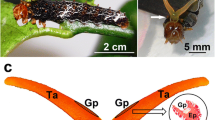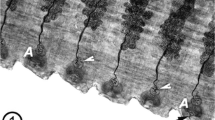Summary
The wall of the receptaculum seminis of Thermobia domestica is composed of numerous glandular units, each with four enveloping cells (denoted 1 to 4) separated by ordinary epithelial cells and associated with a cuticular apparatus. During the moulting periods, which continue to occur in the adult stage, these cells undergo a series of transformations. Just before apolysis there is a dedifferentiation of numerous cytoplasmic organelles, but no mitosis has been observed. When the intima lifts off, the apical system of each glandular unit, i.e. the distal parts of the C2 and C3 cells surrounding the end apparatus, is also eliminated. Then at the apex of each glandular unit, a new ductule is formed in the cavity of which a long ciliary process grows up from cell C1. Finally comes the phase of cuticle formation, i.e., epicuticle for the ductules, epi-and endocuticle for the intima lining the central cavity of the receptaculum. Various cell types participate in secretion of cuticle, the ciliary cells (C1) being responsible for the formation of the porous end apparatus. At ecdysis almost all of the new intima has been secreted and the apical systems are once more differentiated. These transformations are compared with those recently described in other exocrine glands of arthropods, e.g., tegumentary glands and accessory glands of the genital ducts.
Similar content being viewed by others
References
Barbier R (1974) Présence de structures ciliaires au cours de l'organogenèse des glandes collétériques de Galleria mellonella L. (Lépidoptère Pyralide). Colloque S.F.M.E., Rennes, J Microsc 20:18a-19a
Barbier R (1975) Différenciation de structures ciliaires et mise en place des canaux au cours de l'organogenèse des glandes collétériques de Galleria mellonella L. (Lépidoptère, Pyralidae). J Microsc 24:315–326
Berry SJ, Johnson E (1975) Formation of temporary flagellar structures during insect organogenesis. J Cell Biol 65:489–492
Bitsch J (1981) Ultrastructure de l'épithélium glandulaire du réceptacle séminal chez Thermobia domestica (Thysanura Lepismatidae). Int J Insect Morphol Embryol 10:247–263
Bitsch J, Palévody C (1976) Modifications ultrastructurales des glandes vésicularies des Machilidae (Insecta Thysanura) au cours des cycles de mue. Zoomorphologie 83:89–108
Bitsch J, Rojo de la Paz A, Mathelin J, Delbecque J-P, Delachambre J (1979) Recherches sur les ecdystéroïdes hémolymphatiques et ovariens de Thermobia domestica (Insecta Thysanura). C R Acad Sci Paris 289 D: 865–868
Caruelle J-P, Caruelle D (1978) Action in vivo des glandes de mue et de l'ecdystérone sur le comportement du tégument larvaire de Schistocerca gregaria Forsk, Insecte orthoptéroïde. C R Acad Sci Paris 2860:969–972
Cassier P (1977) La différenciation imaginale du tégument chez le criquet pélerin Schistocerca gregaria Forsk. IV. Les étapes de la morphogenèse des unités glandulaires. Arch Anat Microsc Morphol Exp 66:145–161
Happ GM, Happ CM (1977) Cytodifferentiation in the accessory glands of Tenebrio molitor. III. Fine structure of the spermathecal accessory gland in the pupa. Tissue Cell 9:711–732
Juberthie-Jupeau L, Juberthie C (1980) Cycle des téguments, cycle des glandes mandibulaires et taux des ecdystéroïdes dans un intermue chez Hanseniella ivorensis (Myriapode, Symphyle). Bull Soc Zool Fr 105:65–71
Juberthie-Jupeau L, Nguyen Duy-Jacquemin M (1979) Présence d'une phase ciliaire cyclique dans les cellules sécrétrices des glandes du tentorium de Polyxenus lagurus (Myriapoda, Diplopoda). C R Acad Sci Paris 288 D:505–507
Lai-Fook J (1973) The fine structure of Verson's glands in molting larvae of Calpodes ethlius (Hesperiidae, Lepidoptera). Can J Zool 51:1201–1210
Lawrence PA, Staddon BN (1975) Pecularities of the epidermal gland system of the cotton stainer Dysdercus fasciatus Signoret (Heteroptera: Pyrrhocoridae). J Ent (A) 49:121–130
Quennedey A, Brossut R (1975) Les glandes mandibulaires de Blaberus craniifer Burm. (Dictyoptera, Blaberidae). Développement, structure et fonctionnement. Tissue Cell 7:503–517
Quennedey A, Sreng L (1976) Dégénérescence cellulaire durant l'organogenèse des glandes tergales de Blattella germanica mâle (Insecte, Dictyoptère) au cours de la mue imaginale. Bull Soc Zool Fr 101, suppl no 5:9–14
Sbrenna G, Sbrenna-Micciarelli A (1980) Ultrastructure and morphogenesis of the abdominal integumental gland of Schistocerca gregaria Forsk. (Orthoptera: Acrididae). Int J Insect Morphol Embryol 9:1–14
Selman K, Kafatos FC (1975) Differentiation in the cocoonase producing silkmoth galea: ultrastructural studies. Dev Biol 46:132–150
Sreng L, Quennedey A (1976) Role of a temporary ciliary structure in the morphogenesis of insect glands. An electron microscope study of the tergal glands of male Blattella germanica L. (Dictyoptera, Blattellidae). J Ultrastruct Res 56:78–95
Author information
Authors and Affiliations
Rights and permissions
About this article
Cite this article
Bitsch, J. Ultrastructural modifications of the glandular epithelium of the receptaculum seminis in Thermobia domestica (Insecta: Thysanura) during the moulting period. Cell Tissue Res. 220, 99–113 (1981). https://doi.org/10.1007/BF00209969
Accepted:
Issue Date:
DOI: https://doi.org/10.1007/BF00209969




